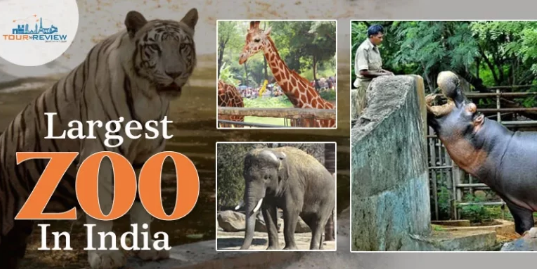India is home to a rich diversity of wildlife, from majestic tigers and elephants to colorful birds and rare reptiles. Zoos across the country play a vital role in preserving this biodiversity and educating the public. Among all these facilities, one stands out for its size, conservation initiatives, and visitor experience — the largest zoo in India. This massive wildlife park attracts millions of tourists every year and continues to evolve as a leading center for research, rescue, and rehabilitation.
Spread across hundreds of acres, the largest zoo in India offers much more than a casual sightseeing trip. It provides a deep connection to nature, allowing visitors to observe animals in habitats that closely resemble their natural environment. For families, students, researchers, photographers, and animal lovers, visiting this zoo becomes both an educational and memorable experience.
Where Is the Largest Zoo Located?
The title of the largest zoo in India belongs to the Arignar Anna Zoological Park, also known as Vandalur Zoo, located near Chennai in Tamil Nadu. Established in 1855, it is one of the oldest zoos in the country and covers more than 1,500 acres. Over time, it has grown into a modern facility with protected forest patches, walking tracks, safari enclosures, and specialized animal care centers.
The geographical location contributes to its lush green landscape, making it an ideal home for hundreds of species. Its natural surroundings help reduce stress for animals and create an enjoyable environment for visitors.
What Makes This Zoo Special?
The primary reason the largest zoo in India stands out is not just its size but also its approach to conservation and animal welfare. The park focuses on providing animals with spacious enclosures rather than compact cages. Many habitats are designed to mimic forests, grasslands, wetlands, or deserts, depending on the species.
Some features that make the zoo unique include:
- Dedicated rescue and rehabilitation center
- Safari zones
- Butterfly and reptile houses
- Walk-through aviaries
- Veterinary hospital with modern facilities
- Breeding programs for endangered species
These efforts support long-term wildlife conservation and help restore population numbers of threatened species.
Wildlife Species You Can See
Visitors to the largest zoo in India can observe more than 2,500 animals representing over 160 species. These include mammals, reptiles, amphibians, birds, and aquatic species.
Some major attractions include:
- Bengal Tiger
- Lion
- Indian Elephant
- Gaur
- Leopard
- Hippopotamus
- Rhinoceros
- Zebra
- Ostrich
- Crocodiles and snakes in the reptile house
The zoo also features rare and exotic species from Africa, Australia, and Southeast Asia, giving visitors a global wildlife experience.
Safari Experience
One of the most exciting parts of visiting the largest zoo in India is the safari experience. Instead of walking past enclosures, visitors ride in protected vehicles to observe animals living in wide open spaces. The lion and deer safari zones are especially popular, providing a thrilling yet safe encounter with wildlife.
The safari model is not only engaging but also aligned with natural habitat design principles.
Visitor Experience and Facilities
The management of the largest zoo in India ensures a smooth experience for visitors. The environment is family-friendly, with plenty of:
- Resting areas
- Food courts
- Information boards
- Guided tours
- Wheelchair accessibility
- Electric vehicles for elderly visitors
Maps are available at the entrance, and digital navigation tools make it easy to plan your route based on interest and available time. Photography is allowed in most areas, making it a perfect outing for wildlife enthusiasts.
Educational Programs
Education is one of the core objectives of the largest zoo in India. Schools, colleges, and universities frequently organize field trips here. The zoo conducts:
- Conservation workshops
- Animal behavior observation programs
- Wildlife talks
- Student volunteering camps
These initiatives inspire the next generation to care about environmental protection and wildlife preservation.
Importance of Conservation Efforts
As human presence expands, wildlife habitats shrink. Zoos like this play an essential role in ensuring that endangered species survive and thrive. Breeding initiatives in the largest zoo in India have already helped protect species such as the white tiger, Indian rhinoceros, and various birds and reptiles.
Through collaborations with wildlife departments and research institutions, the zoo contributes valuable scientific data, rescue missions, and rehabilitation support for injured or displaced animals.
Best Time to Visit
While the zoo remains open year-round, the best time to visit is:
- November to February (pleasant weather)
- Early mornings or late afternoons (more animal activity)
Weekdays are usually less crowded, offering a more peaceful experience.
Tips for Visitors
To make the most of your trip, consider the following:
- Wear comfortable walking shoes
- Carry water and sun protection
- Avoid feeding animals
- Maintain silence near enclosures
- Follow safety and cleanliness rules
Respecting wildlife ensures a safe and enjoyable visit for everyone.
Final Thoughts
The largest zoo in India is not just a tourist spot — it is a living symbol of care, conservation, and curiosity. It brings people closer to wildlife while building awareness about protecting nature. Whether you're planning a family outing, a school visit, or a solo photography trip, this zoo offers a rewarding and educational experience.
By supporting zoos committed to ethical practices and conservation, we help secure a sustainable future for endangered species and preserve the natural balance of our planet.





Comments